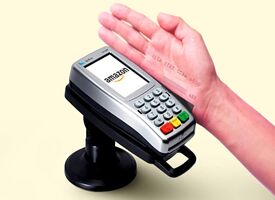亚马逊将推出"徒手"支付
|
Forget the titanium Apple Card — Amazon's latest payment method uses flesh and blood. The e-tailing giant's engineers are quietly testing scanners that can identify an individual human hand as a way to ring up a store purchase, with the goal of rolling them out at its Whole Foods supermarket chain in the coming months, The Post has learned. Employees at Amazon's New York offices are serving as guinea pigs for the biometric technology, using it at a handful of vending machines to buy such items as sodas, chips, granola bars and phone chargers, according to sources briefed on the plans.
The high-tech sensors are different from fingerprint scanners found on devices like the iPhone and don't require users to physically touch their hands to the scanning surface. Instead, they use computer vision and depth geometry to process and identify the shape and size of each hand they scan before charging a credit card on file. The system, code-named "Orville," will allow customers with Amazon Prime accounts to scan their hands at the store and link them to their credit or debit card. It's accurate to within one ten-thousandth of 1%, but Amazon engineers are scrambling to improve it to a millionth of 1% ahead of its launch, the source said. Amazon hopes to introduce the tech to a handful of its Whole Foods stores by the beginning of next year and to eventually expand the super-fast checkout tech to all US locations. The pace of the rollout will depend on how quickly Whole Foods is able to install it and train employees on how to use it, sources said. "We don't comment on rumors or speculation," an Amazon spokesperson said. While a regular card transaction typically takes between three and four seconds, Amazon's new technology can process the charge in less than 300 milliseconds, a person familiar with the project said. "Retailers have always been interested in faster checkout," Majd Maksad, founder and CEO of Status Money, a personal finance site, told The Post. "You only have to walk into Whole Foods to see the massive lines of people waiting to check out. It's a massive friction point." If successful, the technology also could help encourage consumers to spend more when they visit Whole Foods, he said. "People tend to spend more when they don't have the experience of touching something tangible like money," Maksad said. "The utility of money becomes more ephemeral." At Amazon's budding chain of "Go" convenience stores that launched last year, customers use a phone app to check in at a turnstile. They can then fill their bags and carry them out without ever passing a register thanks to computer vision and an array of sensors all over the store. With the new, hand-based tech, shoppers won't even have to bring their phones. Nevertheless, experts say it's unclear whether customers will be enthusiastic about scanning their hands at Whole Foods. |









